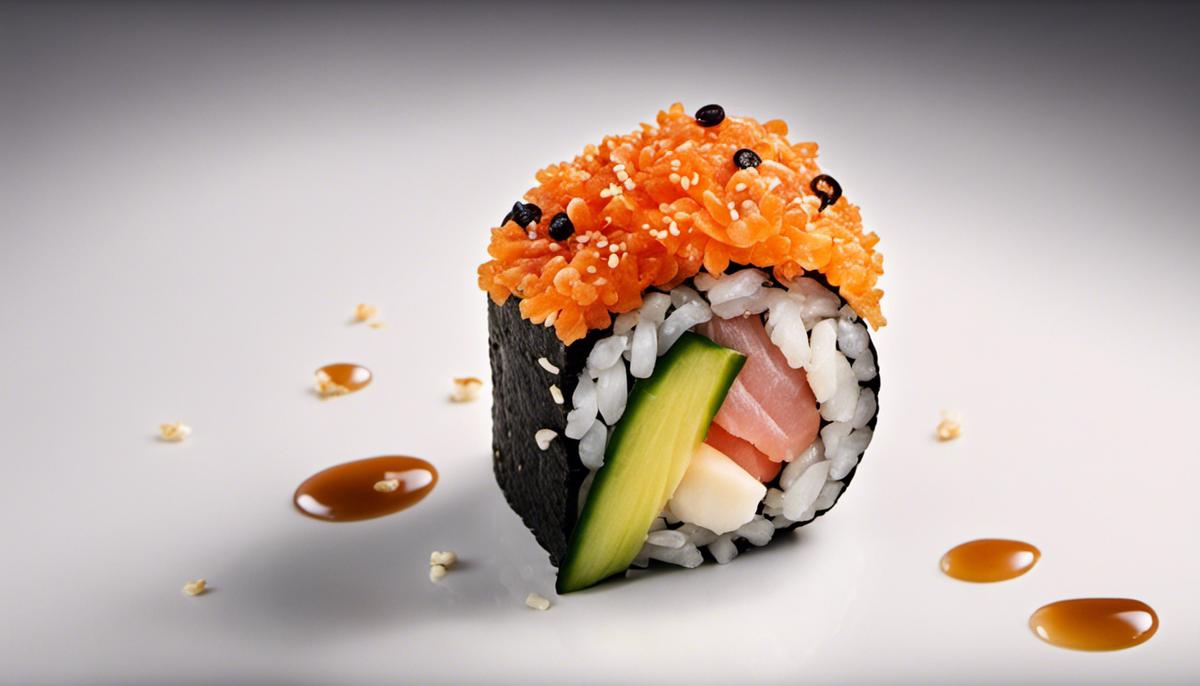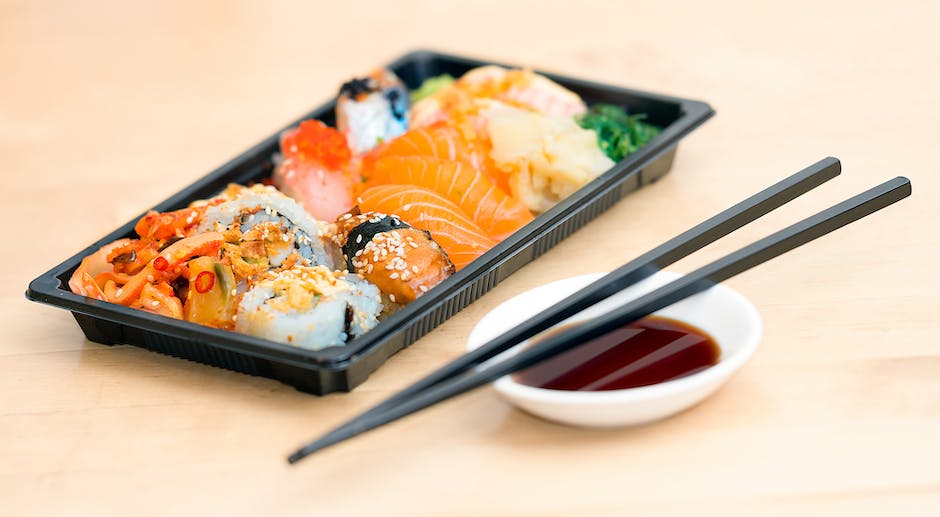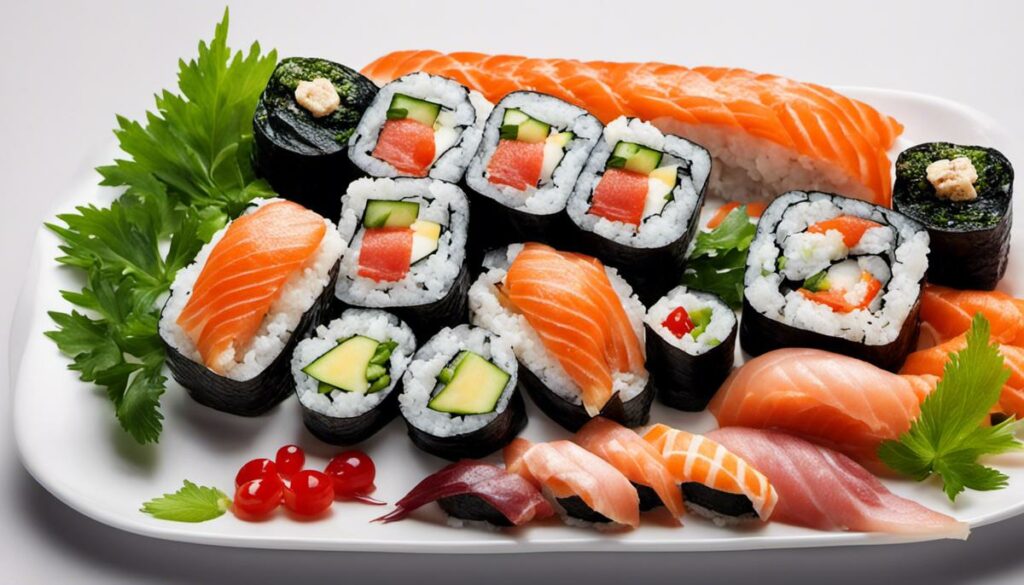The world of food is constantly changing and evolving, and among the culinary trends that have made waves in recent years, sushi is high on the list as a healthy food option. It’s more than just a meal; Sushi represents a millennia-old tradition and has become a global phenomenon of taste and health over the years. With its unique combination of fresh ingredients, including raw fish, seaweed (nori) and rice, sushi not only offers a palette of colorful flavors and textures, but also numerous nutrients such as omega-3 fatty acids, protein, and fiber. This composition of nutrients, together with the right preparation and selection of ingredients, gives sushi its healthy character and makes it one of the most popular nutritional options worldwide.
The Nutritional Profiles of Different Sushi Rolls
When it comes to finding the perfect balance between flavor and health benefits, sushi is definitely at the top of the list. Whether you’re a fan of crispy tempura, creamy avocado rolls, or even simple classics like the California roll, sushi is not only delicious but also nutritionally rewarding. But what makes sushi so healthy?
Let’s start with the main ingredients. The shining star of any sushi roll is undoubtedly the fish. Rich in omega-3 fatty acids, fish provides a healthy dose of protein that helps build muscle while lowering the risk of heart disease. Tuna, salmon, and mackerel are just a few of the fish that will provide you with these healthy benefits.
In addition to fish, a variety of vegetables are wrapped in the rolls. You may find avocado, cucumber, carrot, or even pickled radish. Regardless of the selection, the vegetables in it provide fiber that helps digestion and vitamins that support overall health.
The seaweed or nori packaging it contains is an often overlooked, but equally important ingredient. Nori is rich in iodine, a mineral needed to support thyroid function, and it also contains various B vitamins and vitamin C.
Let’s not forget the rice, which is usually white and provides the sticky aspect of the rolls. While white rice is often thought of as low in nutrient density, it still provides a decent amount of energy in the form of carbohydrates. For those looking for whole grain alternatives, there’s always the brown rice option.
Finally, the soy sauce, pickled ginger and wasabi, which are often added, not only delight our palate, but also contribute to our well-being. Soy sauce provides a small amount of protein, pickled ginger helps with digestion, and wasabi contains antioxidants.
Sure, there are a few aspects to look out for, like the salt content in the soy sauce or the calories in the tempura, but overall, sushi is a coherent example of how delicious food can also be healthy. So why not enjoy a sushi roll at your next brunch? With a bit of soy sauce and a pinch of wasabi, it’s an irresistible treat. Thus, it is possible to delight the discerning palate while enjoying a nutritious meal. It’s simply a matter of choosing the right ingredients and balancing.

The History of Sushi
The Evolution of Sushi: Health Meets Aesthetics
Sushi has been constantly evolving, and that shows its health benefits. In addition to being delicious and aesthetically pleasing, sushi is also health-centric. This dynamic has only been properly recognized in recent decades. Let’s face it, who can resist the delicious taste and unique color of sushi?
Is the sushi revolution just a fad or is there more to it? Let’s try to answer this question by exploring the ongoing development of sushi and the health benefits associated with it.
Modern sushi manifests a fine combination of tradition and innovation. The creative use of ingredients and the incorporation of certain cooking techniques have led to a changeable yet healthy sushi variant. Take, for example, the use of brown rice instead of the traditional white rice. This innovation leads to higher fiber and protein intake, limits the consumption of simple sugars, and reduces the risk of heart disease.
In addition, the use of fresh, high-quality ingredients has contributed to the wellness focus of modern sushi. Due to the variety of fish and vegetables used, you get an abundance of minerals, vitamins and antioxidants. For example, salmon contains the important substance astaxanthin, a powerful antioxidant with an anti-aging effect. And thanks to the low-fat nature of the fish, the calorie content remains relatively low.
But what remains of traditional sushi? Well, there’s a plethora of health benefits in there too. The nori seaweed sheets are rich in iodine, which is essential for the healthy functioning of the thyroid gland. In addition, the ginger used in sushi contributes to the health of the digestive tract, while wasabi has an anti-inflammatory effect.
However, it’s imperative to consider the moderate use of soy sauce and its high salt content, as well as the calories in some of the richer pieces of sushi, to achieve a healthy balance. Although modern sushi innovations sometimes seem far removed from their quaint, traditional roots, one thing remains clear: sushi is a perfect example of how enjoyment and health can go hand in hand.
In this way, the evolution of sushi remains exciting, innovative and health-conscious. May we continue to enjoy this delicious journey.

Sushi preparation and ingredient selection
When preparing sushi, the choice of ingredients and the way they are combined play a key role in reaping the full benefits of its health benefits. The aesthetics and taste of sushi depend heavily on the artistic design and the ingredients used. But were you aware that the way sushi is prepared and served can also affect the health benefits?
First of all, think of raw fish, one of the main ingredients of sushi. Raw fish contains nutritionally important substances such as proteins and omega-3 fatty acids. However, if you’re overweight, sushi that contains high amounts of raw fish could increase your calorie and fat content. That’s why it’s important to find a balance and regulate fish consumption, especially if you’re on a low-calorie diet.
The choice of vegetables in your sushi can also make a difference. For example, avocados contain healthy fats, but also a lot of calories. On the other hand, cucumbers contain fewer calories and are perfect if you’re looking for a low-calorie option. So, make sure you choose your veggies wisely to optimize the nutritional value of your sushi.
Like the rice/nori ratio, it can also have a big impact on the nutritional value of sushi. Nori is rich in vitamins and minerals and contains fewer calories than rice. So, if you’re trying to eat healthy, you might want to prefer sushi with more nori and less rice.
The way your sushi is seasoned can also have significant health effects. Soy sauce, for example, contains a lot of sodium, which can have a negative effect on blood pressure. Alternatively, you could opt for low-sodium variants or skip seasoning with soy sauce altogether.
It should also be noted that some popular types of sushi, such as deep-fried sushi or those with mayonnaise toppings, contain more calories and fat. So, if you prefer healthy options, you might want to avoid such types of sushi.
Apart from the selection and preparation of ingredients, the way we eat sushi also plays an important role. It is recommended to eat sushi in small bites to enjoy the different flavors and textures. Likewise, you should take your time to eat and enjoy every meal consciously. Not only can this practice help prevent overeating, but it can also improve the overall eating experience.
In conclusion, the preparation of sushi and the choice of ingredients can affect the health benefits. It’s all about finding the balance that’s best for your individual tastes and health needs. Make sure you always use fresh and high-quality ingredients. Sushi is more than just a dish. It’s an art form, a science, and a philosophy of life that can benefit our health.

Health Benefits and Potential Risks of Sushi
The aesthetics of sushi are part of its charm.
The balance of flavor and texture, the combination of raw fish and cooked rice, emphasized by the subtle aromas of seaweed and vegetables.
Of course, it’s also a visually stunning meal, an artful masterpiece with every bite.
But it’s not just a treat for the eyes and taste, sushi also has a plethora of health benefits.
And that’s exactly what makes it a salvo for body and mind.
Despite its many benefits, you also need to know the risks associated with consuming sushi.
The main concern here is food poisoning, which can result from eating raw fish.
Listeria, salmonella, and other bacteria can lurk in undercooked fish or seafood.
It is therefore important to buy sushi only from trusted sources and consult it in case you feel unwell.
Another equally important risk factor is the high levels of mercury in some fish species such as tuna, swordfish and king mackerel.
The consumption of such fish should be limited, especially in pregnant women and young children, who are more sensitive to mercury.
Sushi also contains a lot of rice, which in turn has a high amount of carbohydrates.
For people who want or need to follow a low-carb diet, this could be problematic.
Luckily, many modern sushi restaurants show flexibility in terms of ingredients, offering options with less rice or even rice-free rolls.
It should also be noted that some sushi variations, such as tempura or mayonnaise-covered rolls, have a higher fat and calorie content.
It’s important to consider these factors when making health-conscious choices.
Bottom line: Sushi is a delicious, healthy choice with many benefits, but as with anything, moderation is key.
Pay attention to the origin of your sushi, the ingredients you choose, and how often you consume it.
Eating consciously means knowing what you eat and how it affects the body.
Then you can sit down, relax, and enjoy every delicious bite.
Enjoy your meal!

Sushi in the modern diet
Certainly one of the pilgrimage destinations in the world of modern health awareness is Japanese cuisine and, in particular, the art of sushi.
For good reason, sushi has established itself in the hearts and stomachs of the health-conscious and taste enthusiasts – it is the ultimate symbiosis of enjoyment and health.
Sushi fits perfectly into the modern healthy lifestyle, which focuses not only on choosing the right food, but also on the way of eating.
Sushi allows you to enjoy a meal more consciously.
It’s like a little holiday in the middle of everyday life – we eat it with our hands, take our time to recognize the nuances of taste and let ourselves be enchanted by the visual play of colors and shapes.
An important aspect is the aesthetics of sushi.
Hardly any other delicacy offers such a celebration for the eyes.
The visually stunning masterpieces are edible works of art that instantly grab attention on Instagram and other social media channels.
The bright colors, neat arrangement and creative presentation make the simple meal a feast for the eyes.
Plus, sushi offers an intuitive balance of flavor and texture.
The combination of rich, raw fish and mild, cooked rice creates a perfect harmony, which is further enhanced by the subtle flavors of seaweed and vegetables.
Sushi requires both skill in preparation and mindfulness in consuming it, and every bite is a tribute to nature’s simple elegance.
But it would be reckless to ignore the potential risks of consuming sushi.
Although sushi offers many health benefits, consuming raw fish can also lead to food poisoning.
In addition, highly contaminated fish can be contaminated with mercury.
Finally, it’s important to note that not all types of sushi are created equal.
While traditional sushi consists mainly of rice, fish and vegetables, many modern variations have a high fat and calorie content due to additional ingredients such as mayonnaise or fried toppings.
With the health aspect in mind and meeting our fitness goals, it’s important to choose the right sushi and enjoy it in moderation.
Conscious eating, the selection of high-quality ingredients and a balanced diet are the key to a modern, healthy lifestyle.
Sushi fits perfectly into this picture – it is not only delicious, but also a visual and gustatory delight that nourishes our body and soul.
It’s more than just a meal – it’s an experience.

Photo by viniciusbenedit on Unsplash
The appeal of sushi lies in the combination of its aesthetic presentation, its diversity and its nutritional profile. It combines the best of the world of taste and health and fits seamlessly into a balanced and healthy lifestyle in today’s time and culture. Conscious consumption of sushi, which also includes healthy ingredient selection and preparation, can make a positive contribution to heart health, weight management, and even mental well-being. However, we also need to be mindful of potential risks such as raw fish and rice. If we take this into account, sushi can be a valuable addition to our diet plan and serve as a healthy option that offers pleasure of eating and health benefits in equal measure.


